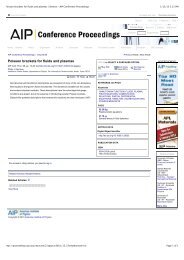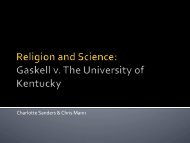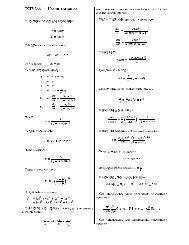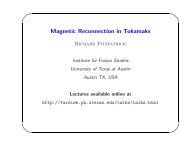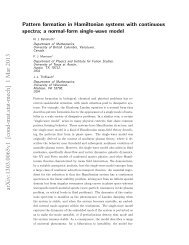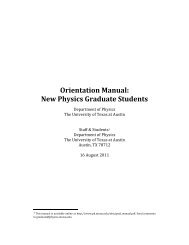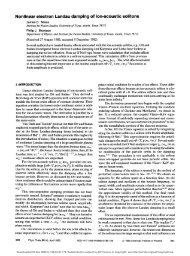Magnetic Fields and Magnetic Diagnostics for Tokamak Plasmas
Magnetic Fields and Magnetic Diagnostics for Tokamak Plasmas
Magnetic Fields and Magnetic Diagnostics for Tokamak Plasmas
Create successful ePaper yourself
Turn your PDF publications into a flip-book with our unique Google optimized e-Paper software.
<strong>Magnetic</strong> fields <strong>and</strong> tokamak plasmas<br />
Alan Wootton<br />
Figure 17.7. The (m,n) space, with the limits imposed by q 0 = 1<br />
<strong>and</strong> q a = 3.2. The darker shaded area represents the space<br />
considered in the analytic model described in the text.<br />
The measurements of the fluctuating fields are usually restricted to root means square (rms)<br />
fields, b rrms <strong>and</strong> b θrms , at r > a, the limiter radius. We would like to know how this is related to<br />
the field components at the resonant surface, so that we can calculate associated isl<strong>and</strong> widths.<br />
Typically we want to determine b rmn from a measured b θrms outside r mn . There is no unique<br />
trans<strong>for</strong>mation from b θrms to b rmn , so a model must be invoked.<br />
We proceed by assuming the fluctuating self generated field b θrms measured with magnetic<br />
probes at r > a is proportional to the required b rmn at r mn ≈ a. Evidence <strong>for</strong> such a model comes<br />
from correlation measurements between Langmuir probes <strong>and</strong> magnetic probes; the measured<br />
b θrms at r > a is apparently determined by plasma current fluctuations at r ≈ a, i.e. at the plasma<br />
edge. Outside the fluctuating current filaments (r > r mn ) the magnetic fields can be approximated<br />
by<br />
b r<br />
=<br />
⎛<br />
r<br />
∑( b rmn<br />
) ⎜<br />
m ,n r<br />
r= r mn<br />
⎝ mn<br />
⎞<br />
⎟<br />
⎠<br />
−(m +1)<br />
cos(mθ + nφ +δ mn<br />
) 17.29<br />
with φ the toroidal angle, θ the poloidal angle, <strong>and</strong> δ mn a r<strong>and</strong>om phase. This ignores toroidal<br />
effects, which introduce terms proportional to (m±1), <strong>and</strong> is strictly valid only <strong>for</strong> small n. If a<br />
conducting wall is present at r = b then the expression is modified by the factor [1-(r/b) 2m ]. For<br />
stationary ergodic turbulence the time <strong>and</strong> spatial averages are the same, so that the root mean<br />
square is found as a spatial average. Outside the singular surface we measure<br />
128



